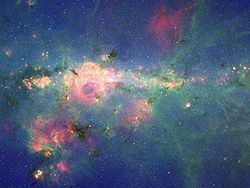Magnitude 8.8 J−K color index 4.2 Apparent magnitude (J) 13.0 | J−H color index 2.7 Apparent magnitude (H) 10.3 | |
 | ||
Similar LBV 1806‑20, Beta Sagittarii, KW Sagittarii | ||
WR 102ka, also known as the Peony star, is a Wolf-Rayet star that is one of several candidates for the most luminous known star in the Milky Way. An even more luminous yet closer star, WR 25, appears to be most likely to the title. Another nearer star Eta Carinae, which was the second brightest star in the sky for a few years in the 19th century, appears to be slightly more luminous than WR 102ka, but is known to be a binary star system. There is also the more recently discovered Pistol star that, like the Peony star, derives its name from the shape of the nebula in which it is embedded, and which it has probably created through heavy mass loss via fierce stellar winds and perhaps also major "mini-supernova-like" eruptions as happened to Eta Carinae around the 1830s-1840s creating the lobes observed by the Hubble Space Telescope.
The luminosities of the Pistol Star, Eta Carinae, and WR 102ka are all rendered somewhat uncertain due to heavy obscuration by galactic dust in the foreground, the effects of which must be corrected for before their apparent brightness can be reduced to estimate their total radiated power or bolometric luminosity. Both Eta Carinae and WR 102ka are believed likely to explode as supernovas or hypernovas within the next few million years. As is typical of such extremely massive and luminous stars, both have expelled a considerable portion of their initial mass, when originally formed, in dense, massive stellar winds.
As WR 102ka lies near the Galactic Center, it is the more distant and heavily obscured of the two, and is essentially totally obscured in visible wavelengths. Thus it must be observed in longer wavelength infrared light, which is able to penetrate the dust. The Spitzer Space Telescope observed WR 102ka at wavelengths of 3.6 µm, 8 µm, and 24 µm on April 20, 2005. The observations were carried out by L. Oskinova, W.-R. Hamann, and A. Barniske of Potsdam University, Germany.
WR 102ka was previously observed by the Two Micron All Sky survey (2MASS) in the near-infrared J, H, and Ks bands, at 1.2 µm, 1.58 µm, and 2.2 µm, respectively.
